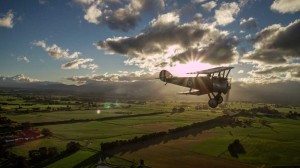
Filmmakers Ron King and Darroch Greer recently tapped Burbank-based post house AlphaDogs to help finish the independent documentary The Millionaires’ Unit: U.S. Naval Aviators In The First World War. In the documentary audiences are taken on a journey back in time into the fascinating story of how a small group of militia airmen from Yale formed the first naval air reserve unit at the outbreak of World War I, and changed the face of naval aviation forever.
Resources were scarce at the beginning of World War I with the U.S. Naval Aviation consisting of just 48 officers and 239 enlisted men who had very limited aviation experience, not to mention that there were only 54 aircraft available that were inadequately equipped for warfare. In 1916 the “The First Yale Unit” – otherwise known as “The Millionaires’ Unit” – was formed. Comprised of 29 Yale college students, these courageous men taught themselves how to fly aircraft such as the Sopwith Camel, SPAD VII, the Curtiss Model F flying boat and more. The students became what is now known as the first naval air reserve unit.
Seven years in the making the filmmakers had to sprint in the end to make the deadline in time for the EAA AirVenture Air Show in Oshkosh, WI, which was less than a month away.
“When you’re bringing your baby to be cared for by strangers, it takes a sucked-in-gut and a leap of faith to sign on with a new post-house,” said Greer. “You want the post crew to take it to heart and treat it as tenderly and thoughtfully as you would yourself. The staff confidently said they could accommodate us and their energy never flagged.”
The film incorporated a wide range of source footage and mixed formats, each requiring a different look and feel for the story. AlphaDogs colorist Sean Stack worked one-on-one with the filmmakers in setting the look for the film. “Sean’s curiosity and attention to the story were thoughtful and encouraging,” said Greer. “Most of our WWI footage was shot in New Zealand with Red Epic Cameras using the same color palette, yet the footage had to represent the pilots training and four separate battle/dogfight sequences. Sean was able to give them all their own verisimilitude. New Zealand is beautiful and hardly looks war-torn, yet with desaturation and special attention to black levels, Sean gave several of the scenes an ominous and deadly feel.”
In addition, Stack also gave vintage photographs and recently shot HD interviews an overall balanced look to fit seamlessly into the story without becoming a distraction to viewers. Dynamic range was then added revealing detail in darker areas that would not otherwise be noticed including the expression of emotion on the pilots’ faces. “Aerial photography and vintage airplanes along with real stories of courageous young heroes – it’s true American history, it’s great to take part in telling the stories,” said Stack.
Due to the high amount of low-resolution archival footage Stack decided it would be beneficial to work creatively in an unlocked timeline to expedite the postproduction workflow. “Working in an unlocked timeline is not typical. It was quite a feat of organization. We added about a dozen partial timelines together that allowed us to get all the graded media assembled together,” said Stack. “It’s a bit unusual to move forward without a completely locked full resolution timeline, be we did it anyway. I couldn’t have done it without the help of the conform editor and the director working together in a collaborative environment to keep track of the footage. It was a successful juggling act, and we finished in time for the airshow.”
Using a DaVinci Resolve workflow, Stack was able to work collectively with AlphaDogs graphic design team in creating visual effects for the film. Select visual effects shots were created for the aerial dogfighting scenes and for an extended night bombing sequence where Stack applied a very dark blue grainy look giving a feel of animated realism to the scene. The bombing sequence required POV shots of enemy searchlights, timed to a first person account of the mission. Senior animator and designer Russell Frazier constructed these shots in After Effects from archival photographs and cloud footage, fabricating the search light beams and tracer fire. “Because the visuals illustrated a dramatic and personal account of the battle, our goal was to match the mood and impact of the author’s recollection,” said Frazier.
Another scene Frazier created required billowing smoke to be added to new footage of a vintage aircraft to simulate an emergency landing. The extensive movement of both the plane and the camera required separate tracks for each. The smoke element was created in Trapcode Particular, including the turbulence and wind effects. “The fact that the VFX team was working without visual references and only with written descriptions of WWI-era anti-aircraft fire and searchlights was impressive,” said Greer. “In particular, the 3-D depth that Russell gave the searchlights from the POV of the planes was thrilling.”
AlphaDogs VP of design Sean Williams did additional VFX scenes giving the story additional depth and vigor. “I was excited by the challenge of recreating WWI aerial dogfighting. By blending subtle VFX with beautifully shot footage of vintage planes, I hoped to heighten the drama of an already thrilling story,” said Williams. “Having almost no archival sources of period tracer fire, the evocative written words of the actual pilots were instrumental in setting the look and feel.”
“It was fun plotting the workflow with the color and VFX and in making sure the effects would play against the color palette,” said Greer. “The work – shot-by-shot – continually exceeded expectations.”





